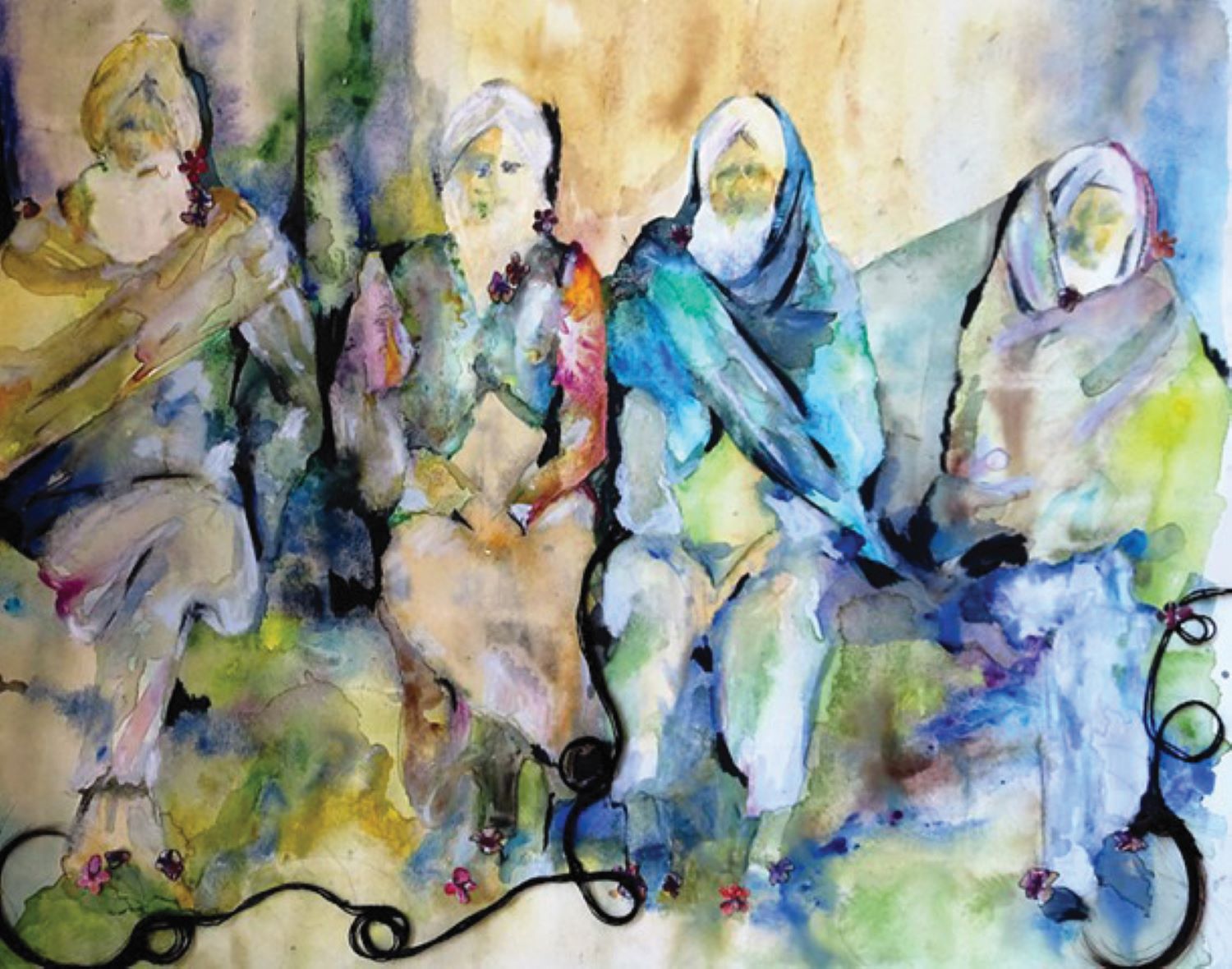IMAGE: Parchaváyn (Shadows) by Navjeet Kaur. Watercolor, coffee, charcoal, hair, and thread on paper. – 2016.
India is in the midst of the largest protest in human history during a global pandemic, with over 250 million people protesting against the capitalist exploitation of small family farmers and laborers. Crowds, largely led by Punjabi farmers, have gathered in Delhi to push back on legislation which serves to remove the Minimum Support Prices (MSP) in favor of deregulation and corporate profit. The legislation will also leave farmers with no legal recourse to challenge corporations, as the bill removes the jurisdiction of civil courts.
These legislative acts will decimate almost 70% of India’s citizens who are engaged in farming, the majority of whom own two acres of land or less. Former Chief Economist of the World Bank, Kaushik Basu, has acknowledged that “the new laws will end up serving corporate interests more than farmers,” and members of the Bharatiya Kissan Union (farmers unions) in India have criticized the far-right BJP Party led by Prime Minister Narendra Modi for forcefully passing legislation which will destroy India’s agricultural industry. Protesters have been met with violent attacks and suppression of speech, including the use of tear-gas, water cannons, and paramilitary action.
While the impetus for the protests was the introduction of legislation that facilitates corporate exploitation, it is important to understand the history of Punjab, and the role of farming in the state’s identity, culture, and economy. Punjab is commonly referred to as the “breadbasket” of India, as the state is flanked by five rivers and has fertile soil for growing wheat, rice, sugarcane, barley, and corn. Punjab’s agricultural production represents a major financial interest for India, particularly as population growth continues.
Deregulation of farming and the forceful demands of multinational companies such as Monsanto are nothing new to India. Since the 1970s, Punjab’s farmers have lived the consequences of losing their land, their livelihood, and their autonomy while the wealthiest of India and abroad thrive. Many Punjabis have felt they were “being used as a colony to produce cheap primary goods while no investment was made” (Dyke, 2009).
So, in 1973, the Shrimoni Akali Dal Party of Punjab listed a set of demands in the Anandpur Sahib Resolution. The Resolution’s demands included:
- Eradication of poverty and starvation through increased production and more equitable distribution of wealth and also the establishment of a just social order sans [without] exploitation of any kind.
- An economic and social structure which provides for the uplift of the poor and depressed sections of society.
- Unabated opposition to the concentration of economic and political power in the hands of the capitalists.
However, these demands were largely ignored, in favor of continuing capitalist expansion and deregulation of the market for the benefit of the elite.
Punjabi farmers often point out the damage done through deregulation to the farming industry in the Indian state of Bihar some 14 years ago. They are also well aware of farming legislation introduced by the World Trade Organization and the International Monetary Fund in Jamaica, which devastated Jamaica’s dairy and banana industry. However, the reach of this deregulation extends far beyond farming, as the North American Free Trade Agreement (which was widely opposed by the labor movement and the working class) served to devastate entire communities of autoworkers in the United States. The forces behind NAFTA reflect many of the same forces behind India’s power grab against farmers – multinational corporations demanding cheaper labor and increased profits.
Capitalist-driven ideologies imposed upon agriculture have led to disruption of natural life cycles, with negative consequences affecting multiple generations. To protect future generations from these long-term harmful impacts, there must be healing. The question is, how can this healing take place in the context of profit-driven dehumanizing structures?
Beyond the economic impact of the legislative policies, it is crucial to understand the depth of love for farming in the state of Punjab and the inextricable connection of the Punjabi people to their land and their crops. Punjabi language, folk tales, music, art, community, and spirituality are all derived from connection to the land. There is a shared sense of reverence and appreciation for the soil and the hands that work the land, sustaining the sense of spirituality and community. This dates back to the first Sikh Guru, Guru Nanak, who himself was a farmer on the same land these farmers are protecting from capitalist exploitation today. Protesters from Punjab say that Punjab is the land of Guru Nanak, strengthening their relationship to their land, spirituality, and identity.
The land of Punjab was where Guru Nanak started “Langar Seva,” which was used to feed the community. However, Langar Seva was not merely “free food,” but a communal engagement where the community joined together to grow, make, and serve food, whilst connecting to one another and the divine energy they share.
Langar challenges the capitalist mindset, where food is viewed as profit, as it positions food as a means of community building and demands food as a basic human right. The revolutionary aspect of Langar is evident, as protesters from Punjab arrived in Delhi with food rations not just for themselves, but for the whole protesting community and neighboring communities. Since the arrival of the Punjabi protesters, the people of Delhi have remarked how they have never had access to food of such quality and quantity. The farmers brought their connections and teachings from the land of Punjab to feed and connect with the people in Delhi. This is what the protesters of Punjab are fighting for.
During the 1947 partition, Punjab was separated into two parts, one now belonging to Pakistan and one belonging to India. In 1984, the state of Punjab was under attack by the Indian Government, as India committed genocide against the Sikh people. Many Punjabi Americans in the United States are one or two generations separated from their farming ancestors, but the pain of losing their land in Punjab is still felt. These events of the past have triggered our generation to speak up for our elders, ancestors, and our spiritual ties to the place that holds our blood memories. The intergenerational connection remains, but the trauma inflicted in the past seeks healing. We want to restore our natural relations—with land, community, history, one another, plants, animals, and mythic stories.
Since arriving in Delhi, protesters have chanted the slogan, “Kissan Mazdoor Ekta Zindabad,” which translates as “Long Live Farmer and Laborer Unity.” This recognition of shared struggle and true allyship bucks the attempts of big business to divide and conquer and firmly positions this protest as one of unity, labor, and community.
The spirit of the protesters and the theoretical framework they operate from extends far beyond the bills proposed in India. They represent the eternal struggle for reclaiming connection to the land and the people and a continuous quest for liberation.


